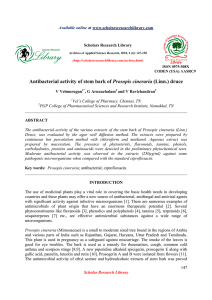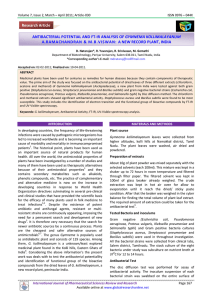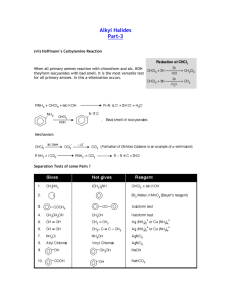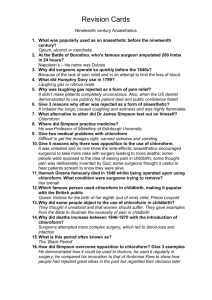Document 14111269
advertisement
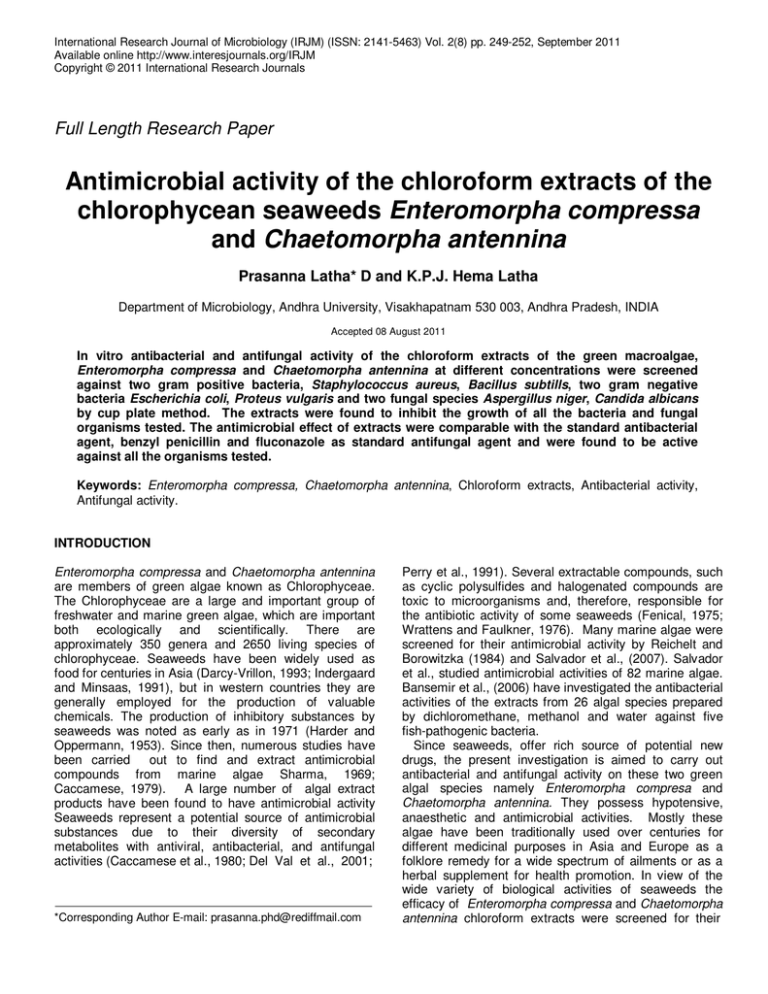
International Research Journal of Microbiology (IRJM) (ISSN: 2141-5463) Vol. 2(8) pp. 249-252, September 2011 Available online http://www.interesjournals.org/IRJM Copyright © 2011 International Research Journals Full Length Research Paper Antimicrobial activity of the chloroform extracts of the chlorophycean seaweeds Enteromorpha compressa and Chaetomorpha antennina Prasanna Latha* D and K.P.J. Hema Latha Department of Microbiology, Andhra University, Visakhapatnam 530 003, Andhra Pradesh, INDIA Accepted 08 August 2011 In vitro antibacterial and antifungal activity of the chloroform extracts of the green macroalgae, Enteromorpha compressa and Chaetomorpha antennina at different concentrations were screened against two gram positive bacteria, Staphylococcus aureus, Bacillus subtills, two gram negative bacteria Escherichia coli, Proteus vulgaris and two fungal species Aspergillus niger, Candida albicans by cup plate method. The extracts were found to inhibit the growth of all the bacteria and fungal organisms tested. The antimicrobial effect of extracts were comparable with the standard antibacterial agent, benzyl penicillin and fluconazole as standard antifungal agent and were found to be active against all the organisms tested. Keywords: Enteromorpha compressa, Chaetomorpha antennina, Chloroform extracts, Antibacterial activity, Antifungal activity. INTRODUCTION Enteromorpha compressa and Chaetomorpha antennina are members of green algae known as Chlorophyceae. The Chlorophyceae are a large and important group of freshwater and marine green algae, which are important both ecologically and scientifically. There are approximately 350 genera and 2650 living species of chlorophyceae. Seaweeds have been widely used as food for centuries in Asia (Darcy-Vrillon, 1993; Indergaard and Minsaas, 1991), but in western countries they are generally employed for the production of valuable chemicals. The production of inhibitory substances by seaweeds was noted as early as in 1971 (Harder and Oppermann, 1953). Since then, numerous studies have been carried out to find and extract antimicrobial compounds from marine algae Sharma, 1969; Caccamese, 1979). A large number of algal extract products have been found to have antimicrobial activity Seaweeds represent a potential source of antimicrobial substances due to their diversity of secondary metabolites with antiviral, antibacterial, and antifungal activities (Caccamese et al., 1980; Del Val et al., 2001; *Corresponding Author E-mail: prasanna.phd@rediffmail.com Perry et al., 1991). Several extractable compounds, such as cyclic polysulfides and halogenated compounds are toxic to microorganisms and, therefore, responsible for the antibiotic activity of some seaweeds (Fenical, 1975; Wrattens and Faulkner, 1976). Many marine algae were screened for their antimicrobial activity by Reichelt and Borowitzka (1984) and Salvador et al., (2007). Salvador et al., studied antimicrobial activities of 82 marine algae. Bansemir et al., (2006) have investigated the antibacterial activities of the extracts from 26 algal species prepared by dichloromethane, methanol and water against five fish-pathogenic bacteria. Since seaweeds, offer rich source of potential new drugs, the present investigation is aimed to carry out antibacterial and antifungal activity on these two green algal species namely Enteromorpha compresa and Chaetomorpha antennina. They possess hypotensive, anaesthetic and antimicrobial activities. Mostly these algae have been traditionally used over centuries for different medicinal purposes in Asia and Europe as a folklore remedy for a wide spectrum of ailments or as a herbal supplement for health promotion. In view of the wide variety of biological activities of seaweeds the efficacy of Enteromorpha compressa and Chaetomorpha antennina chloroform extracts were screened for their 250 Int. Res. J. Microbiol. Table 1: Antibacterial activity of the chloroform extracts of Enteromorpha compressa and Chaetomorpha antennina inhibition zone diameter (mm) Test organisms Chloroform extract of E.compressa 50 µg/ml 100 µg/ml Staphylococcus aureus 10 12 Bacillus subtilis 11 12 Escherichia coli 12 13 Proteus vulgaris 12 13 antibacterial activity against gram positive bacteria Staphylococcus aureus (NCIM 5021), Bacillus subtilis (NCIM 2439), gram negative bacteria Escherichia coli (NCIM 2067), Proteus vulgaris (NCIM 2027) and antifungal activity against Aspergillus niger (NCIM 1055), Candida albicans (NCIM 854) by cup plate method (Kavanagah, 1963). MATERIALS AND METHODS Algal material Enteromorpha compressa and Chatomorpha antennina were collected in bulk quantity from coastal areas of Vizag, Tenneti Park, and Vuda Park, Visakhapatnam district, Andhra Pradesh, India.The algae were identified in the Department of Botany,Andhra University by comparison with herbarium specimen of the Department. Seaweed species exposed on sand and rocks were collected in plastic bags and brought to the laboratory. Each species was washed thoroughly with running tap water to remove epiphytes, animal castings, attached debris and sand particles and finally washed with distilled water and dried under shade. Extraction The collected samples were air-dried and coarsely powdered. The powdered form of Enteromorpha compressa and Chaetomorpha antennina were subjected to step wise extraction using n-hexane, chloroform and methanol by soxhlation process. The three different extraction solvents were used according to the order of their polarity as different compounds get extracted in different solvents. As maximum antimicrobial activity was shown by the chloroform extract and no activity by the other solvent extracts, the emphasis was on the chlorofoem extracts. The crude extracts were concentrated under reduced pressure to get their corresponding residues. The seaweed extracts were further subjected for antimicrobial activity by agar cup Inhibition zone diameter (mm) Chloroform extract of Standard (Benzyl C.antennina penicillin) 50 µg/ml 100 µg/ml 100 µg/ml 9 11 17 9 11 18 10 11 15 11 12 15 Control (DMSO) 8 9 8 8 plate method. (The Cup-Plate Method in Microbiological Assay,with Special Reference to Riboflavine and Aneurine. By AI Bacharach and WFJ Cuthbertson., 1947) Antibacterial activity The cultures of Staphylococcus aureus (NCIM 5021), Bacillus subtilis (NCIM 2439), Escherichia coli (NCIM 2067) and Proteus vulgaris (NCIM 2027) grown overnight at 370 temperature were used for testing the antibacterial activity. Nutrient agar medium (Himedia, India) was dissolved in water (2.8 % w/v) and pH adjusted to 7.0. This was distributed in 25 ml quantities in 100ml conical flasks and were sterilized in an autoclave at 1210 C (15 lbs/sq.in) for 20 minutes. The bacterial culture was added aseptically to the agar medium maintained at 450C, mixed well and poured immediately in sterilized petri plates. After hardening, four cups of 8mm diameter each were cut into agar. 50 µl of test solutions of various concentrations (50 µg/ml, 100 µg/ml) and standard benzlyl penicillin (100 µg/ml) were placed in these cups. Solvent alone in the fourth cup was kept in control. The plates were incubated at 37oC and observations recorded after 24-72 h. Each experiment was carried out in triplicate and the mean diameter of inhibition zone was recorded. The inhibition zones produced by the test solutions were compared with the inhibition zone produced by pure benzyl penicillin used as the standard. The results are presented in Table 1.(Barry AJM, Garcia F and Thrupp LD),Interpretation of sensitivity test results, American Journal of Clinical Pathology,1970,53,140. Antifungal activity Antifungal activity of Enteromorpha compressa and Chaetomarpha antennina chloroform extracts were tested against A.niger (NCIM 1055) and Candida albicans (NCIM 854) using the diffusion plate method (Kavanagh, 1963). In this 0.1 ml of fungal spore suspension (grown for 3 days on 10 mL of nutrient dextrose agar) was thoroughly mixed with 25 ml of melted Potato dextrose Latha and Latha 251 Table 2: Antifungal activity of the chloroform extracts of Enteromorpha compressa and Chaetomorpha antennina. Test organisms Chloroform extract of E.compressa 50 µg/ml 100 µg/ml Aspergillus niger 10 12 Candida albicans 10 12 agar (Himedia, India) and was poured into sterilized petri plates. When the agar solidified, 4 cups of 8 mm diameter were made on each of the seeded plates. These cups were filled with 50 µl of the test samples of various concentrations (50µg/ml and 100 µg/ml) and standard fluconazole (100 µg/ml). Solvent alone in the fourth cup was kept in control. The petri plates were incubated at 280C for 2-4 days. All these experiments were carried out in triplicate. All the culture plates were examined from 24 h onwards and the results are tabulated (Table 2). The inhibition zones produced by the test samples were compared with the inhibition zone produced by fluconazole used as the standard. RESULTS AND DISCUSSION The chloroform extracts of Enteromorpha compressa and Chaetomorpha antennina showed considerable antibacterial and antifungal activities.Different extracts of Enteromorpha and Chaetomorpha were tested for their antimicrobial activity against two strains of Gram positive, Gram negative bacteria and fungal test organisms, by cup plate method. The results of antimicrobial activity against tested pathogens were tabulated in the Tables 1,2 for the crude extractions of Enteromorpha and Chaetomorpha for antibacterial activity and antifungal activity respectively.In case of Enteromorpha and Chaetomorpha,of the various solvents used for sea-weed extractions, maximum inhibition was noticed with the Chloroform extracts and no activity with n-hexane and methanol extractions. The chloroform extract of Enteromorpha compressa (100 µg/ml) showed the significant antibacterial activity against all the tested organisms compared with the standard benzyl penicillin, but the chloroform extract of Chaetomorpha antennina (100 µg/ml) showed moderate activity against the organisms tested with the standard benzyl penicillin. These extracts also showed moderate antifungal activity against the tested organisms compared with the standard fluconazole. Among Gram positive organisms, the Chloroform extract of Enteromorpha showed good antimicrobial activity when compared to the Chloroform extract of Chaetomorpha. Among Gram negative organisms, the Inhibition zone diameter (mm) Chloroform extract of Standard C.antennina (fluconazole) 50 µg/ml 100 µg/ml 100 µg/ml 10 12 15 10 11 16 Control (DMSO) 8 9 Chloroform extract of Enteromorpha showed promising activity while the Chloroform extract of Chaetomorpha showed better activity with Proteus vulgaris when compared to that of Escherichia coli The crude extracts exhibited good activity against Aspergillus niger and good activity against Candida albicans, by the Chloroform extract of Enteromorpha and promising activity against Candida albicans by the Chloroform extract of Chaetomorpha. From the above preliminary studies on the antibacterial and antifungal activities,the crude extracts of the two seaweeds showed promising activity against all the test pathogens,promising a future scope for the use of these marine seaweeds against a range of microbial populations.The work can further be extended to reveal its sources of secondary metabolites that attributes to the antimicrobial activity. ACKNOWLEDGEMENT All the support given by the Department of Microbiology, Andhra University, Visakhapatnam, India is acknowledged. REFERENCES Burrows EM (1991). Seaweeds of the British Isles. Volume 2, Chlorophyta. London: Nat. Hist. Museum Pub. Pp 238 Caccamese S, Azzolina R, Furnari G, Cormaci M, Grasso S (1980). Antimicrobial and antiviral activities of extracts from Mediterranean algae. Bot. Mar. 23: 285-288. Del Val AG, Platas G, Basilio A, Gorrochategui J, Suai I, Vincente F, Portillo E, del Rio MU, Reina GG, Pelaez. F (2001). Screenina of antimicrobial activities in red, green and brown macroalgae from Gran Canaria (Canary Islands, Spain). Int. Microbiol. 4: 35-40. Elena M, Francisco Y. Erickson KL (2001). Mailiohydrin, a cytotoxic chamigrene Dibromohydrin from a philipine, Laurencia species., J. Nat. Prod. 64(6): 790-791. Kavanagh F (1992). Analytical Microbiology-II, Academic press, New York, pp 241- 243. Kazuyuki M (1995). Taxonomic study of the genus Spongomorpha (Acrosiphoniales, Chlorophyta) in Japan, Spongomorpha spiralis. Phycological Research. 44(11): 27-36. Kim J, Hudson B, Huang AM, Bannistes K, Jin A, Choi TJ, Towers GHN, Hong YK, DeWreede RE (1997). Biological activity of seaweed extracts from British, Colombia, Canada and Koria.I. Antiviral activity Can. J. Bot. Rev. 75(10): 1656-1660. Neori A, Cohen I (1991). “ulva lactuca biofilters for marine fish pond effluents. II Growth rate, yield and C:N ratio”. Botanica Marina 34: 252 Int. Res. J. Microbiol. 483-489. Okai Y, Higashi-Okai K, Ishizaka S, Yamashita U (1997). Enhancing effect of polysaccharides from edible brown alga, Hijikia fusiforme (Hijiki). Perry NB, Blunt JW, Munro MHG (1991). A Cytotoxic and antifungal 1,4 naphthaquinone and related compounds from a New Zealand alga Landsburgia quercifolia. J. Nat. Prod. 54: 978. Premila JC, Raviraja NS, Sridhar KR (1996). Antimicrobial activity of Reichelt JL, Borowitzka MA (1984). Antimicribial activity from marine algae: results of a large-scale screening program. Hydrobiologia pp 116-117. Riccardi N, Solidoro C (1996). The influence of environmental variables on Ulva rigida C. Ag. Growth and Production. Botanica Marina 39: 27-32 sea marine algae of south-west coast of India. Ind. J. Mar. Sci. 26(2): 201-205. Zornitsa K, Julia.S, Hristo N, Kamen S, lva T, Stefka DK, Simeon P (2008). Antibacterial, antiviral, and cytotoxic activities of some red and brown seaweeds from the Balck Sea. Botanica Marina. 52,(1): 80-86.
